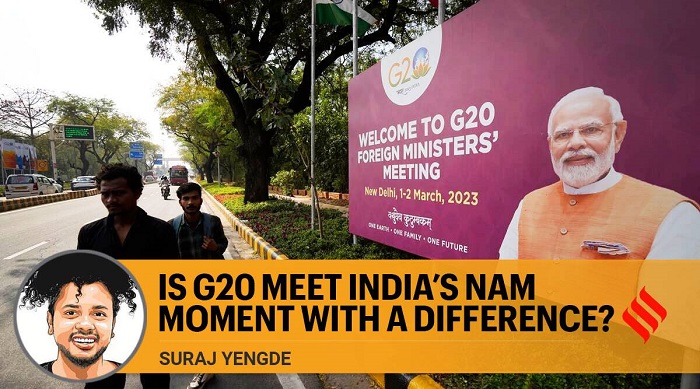
If you are at Washington D.C.’s Dulles International Airport and are on a connecting flight, you will transition from main terminal gates Z to concourse C. No matter which direction you come from, you pass by mid-size advertorial screens that grab the attention of passers-by. Where one is used to seeing models demonstrating clothing brands or fragrances, one will be surprised to notice two Indian men, Narendra Modi and his protégé Shivraj Singh Chauhan, flashing through the screens with the G-20 as backdrop.
The advert was sponsored by the BJP-ruled Government of Madhya Pradesh, which, like other states, is one of the hosts of the G-20 meetings happening throughout the year. India is the host of the latest edition of G-20, a forum of the 20 largest economies in the world. The aim of such a gathering is to collaborate on economic issues but also be another occasion for world leaders to discuss extra-economic issues.
This year’s rotating presidentship coincides with Parliamentary elections due next year. Modi has checked nearly all boxes domestically, or so he thinks, and cannot repeat them. G-20 Presidency comes as a boon to alter the newness of his appeal.
He will bank on it to reinstate his role as a ‘strong world leader’. Once this is achieved, then he can parlay the politics of the advanced economies where foreign relations, global recession, and international war are on the agenda. India has been thus far deeply rooted in regional politics but with the new leadership, it is hoping to up the ante.
What Modi is concerned about and has been consistent throughout is his image and what it represents. The Economist wittily remarked how the logo of the G-20 is designed to amplify the BJP’s party lotus.
The foreign policy consensus has changed, nay ameliorated, over the decades. With the 21st Century advancing on the dialogue pertaining to innovation and development, and no longer colonization, the Indian government is ready to offer a capital-pleasing canvas to the technologically advanced world.
However, its innovation rate remains abysmally low. Tech start-ups in India are cloned versions of business enterprises that originated outside India. It ranks 66th on the Global Innovation Index.
The historical touchstones for India’s foreign policy vision were encoded with a robust development model backed by stories of new enterprises taking shape and old business hubs expanding their international base. However, 90% of India’s startups wind up their shops within five years, Oxford Economics and IBM Institute for Business Value reported.
The fiesta of the G-20 rounds has brought together many divergent voices into one. After all, when it comes to national security and international reputation, everyone is meant to bow to the state policy often regulated by the invisible powers (deep state) not limited to the government.
India is locked between the theology of robust nationalism and the blasphemy of multilateralism. If at all, India has offered historical cues with the Non-Aligned Movement to stand as a strong, meditative, and often mature force to reckon with. Will it continue the groundswell in the era of a divided, war-torn West or will it maintain a Gandhian silence on matters important? As a host country and chair, India has the advantage to broker the deal and if it does, Modi will come across as a new face of the Global South taking on the Global North.
The situation of minorities, rights of the caste oppressed, questions of religious freedom and tolerance, and democratic rights seem to take a third or fourth seat in the face of big monies and oligarchic munificence operated via multi-state associations. India has a chance to reinsert that as its ethical standards and confess to these issues. The BBC episode has certainly tainted the credentials of Modi’s impatience with criticism. No matter how many flyers he may fly in the air or take over screens, Modi might as well be following the Ambedkarite foreign policy without his knowledge, which is to follow innovation, state pragmatic alliances, and be a participant in change.
Heretofore, such conventions and exchanges were geared towards Western interests or P-5 opportunism. This can change if the Global South leadership ascends to think of itself as a truly global player not rusticated to the power plays of giants. With G-20 still seen as a not-yet formal heavyweight, it has the possibility of becoming one. Scholar of the G-20, Steven Slaughter, argues that it is this nature of the grouping that offers it more flexibility. The question is, can India use this opportunity and make its own NAM moment of a different kind? (Indian Express)